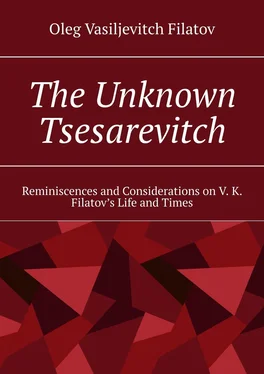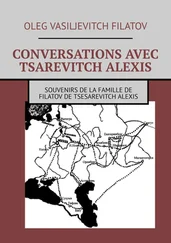Oleg Filatov - The Unknown Tsesarevitch. Reminiscences and Considerations on V. K. Filatov’s Life and Times
Здесь есть возможность читать онлайн «Oleg Filatov - The Unknown Tsesarevitch. Reminiscences and Considerations on V. K. Filatov’s Life and Times» — ознакомительный отрывок электронной книги совершенно бесплатно, а после прочтения отрывка купить полную версию. В некоторых случаях можно слушать аудио, скачать через торрент в формате fb2 и присутствует краткое содержание. ISBN: , Жанр: Историческая проза, на английском языке. Описание произведения, (предисловие) а так же отзывы посетителей доступны на портале библиотеки ЛибКат.
- Название:The Unknown Tsesarevitch. Reminiscences and Considerations on V. K. Filatov’s Life and Times
- Автор:
- Жанр:
- Год:неизвестен
- ISBN:9785449617170
- Рейтинг книги:3 / 5. Голосов: 1
-
Избранное:Добавить в избранное
- Отзывы:
-
Ваша оценка:
- 60
- 1
- 2
- 3
- 4
- 5
The Unknown Tsesarevitch. Reminiscences and Considerations on V. K. Filatov’s Life and Times: краткое содержание, описание и аннотация
Предлагаем к чтению аннотацию, описание, краткое содержание или предисловие (зависит от того, что написал сам автор книги «The Unknown Tsesarevitch. Reminiscences and Considerations on V. K. Filatov’s Life and Times»). Если вы не нашли необходимую информацию о книге — напишите в комментариях, мы постараемся отыскать её.
The Unknown Tsesarevitch. Reminiscences and Considerations on V. K. Filatov’s Life and Times — читать онлайн ознакомительный отрывок
Ниже представлен текст книги, разбитый по страницам. Система сохранения места последней прочитанной страницы, позволяет с удобством читать онлайн бесплатно книгу «The Unknown Tsesarevitch. Reminiscences and Considerations on V. K. Filatov’s Life and Times», без необходимости каждый раз заново искать на чём Вы остановились. Поставьте закладку, и сможете в любой момент перейти на страницу, на которой закончили чтение.
Интервал:
Закладка:
A participant of the execution, 18-year old Netrebin Viktor Nikiforovich records: “The Heir still showed signs of life though a lot of shots had been made…». Recollections of Andrei Strekotin: “Then Ermakov, seeing that there was a bayonet in my rifle, suggested that I stabbed those still alive. I refused. Then he took my rifle and started stubbing them…” (Sverdlovsk Party Archive, f. 41, inv. 1, c. 149, p. 164. References to the archive have been taken from O.A. Platonov’s book). “The shooting stopped. The door was opened to clear the gun-powder smoke… They began to remove the bodies. First the body of the Tsar was removed. The bodies were piled up in a truck.” Andrei Strekotin describes how the bodies were removed, in which order, and he knew exactly when it would be the Heirs’s turn. He had told his brother Alexander that the Heir was the last one taken out and the last one laid in the truck, since that night Alexander did not return to the Ipatiev house. Was the end gate of the truck closed? How high were the sides of the truck?
“There was not enough room in the carts for all the bodies (Auth.: “The truck got stuck five miles from the town, near the Upper-Iset plant».).There were not enough carts which worked well. They were falling apart. (It was already 4:00 or 4:30 in the morning. Who was loading whom? And where to?” – author’s remark). Then it turned out that Tatiana, Olga, and Anastasia had some corsets on.“ 1
When the funeral team noticed during the transfer of the bodies that some bodies were missing, they feverishly began to feel the pulse of the remaining bodies because they understood that those missing remained alive, and only at that moment did they find out that. Tsesarevich Alexei and Grand Duchess Maria were missing, as well as two corsets. That’s why nobody of the funeral team had mentioned in their memoirs that there were two missing children and two missing corsets. That’s why the truck went on to the shaft carrying only part of the bodies. It turns out that there was no post-execution search. Apparently, there was no time. But why? If the executioners knew the Romanovs by sight? Maybe, it had already grown light and they had to hurry? (They did not search Tsesarevich, his mother and other bodies). The conclusion is the following: it means that the escort had lost the bodies before the pause near the Upper-Iset plant and nobody had noticed it. That was an enigma. Father’s words were confirmed. The stealing had begun. In Radzinsky’s 2book Yurovsky says: “I decided to dismiss the team immediately, leaving only some sentries as a guard and five men of the team. The rest left…” Where did the rest go? And what for? When they did not know at all what to do. Did they understand only at that moment that two were missing or was it before? Did they go searching in the dark? Apparently, the jewels were also registered in the dark… Our father was terribly maimed. His back had many scars of various sizes. The scars were 1.5 to 5 cm. The scars in the center were up to 0.8 cm high. There were also scars to 10 cm. There was a shrapnel wound on the left heel, the scar was cross-shaped. Two ribs were broken. By 40 years his left leg was withered and by 1944 became shorter than the right one. On the whole, there were up to 20 scars and bluish dents in his back. Father would buy shoes of different sizes: 40 for his left leg and 42 for his right leg. Because of the wounds, by 1944 his spine had become twisted to the right. We, when children, would ask him about his wounds and disabilities. He would tell us that he had gone to the Finnish war in a coach, but the planes had bombed the train and he, without reaching the front, returned to the hospital. And to the question what he was and why he was in the army he answered that he was a student in Leningrad and all students were called up. Or he would say that he was such from birth, or that he fell from a tree. Such were his answers until we grew up. Later on we understood that those had only been excuses and the reason of his wounds had been of quite another nature. According to the records in his serviceman’s identity card, in 1942 he was exempt from military service. There are no records for other years. So, he was not at the front. At any rate, our family has not got any relevant documents, also. There is no disability certificate. From the evidence of F. P. Proskuriakov, a guard: “… When all of them had been executed, Andrei Strekotin took off their jewels. Yurovsky confiscated them and took them upstairs…“ 1. A question arises. Everything was in gunpowder smoke (the guards were sick, they ran out in the open air and vomited). There was no doctor who could confirm the deaths. Strekotin had a revolver, was he going to gather the jewels in everybody’s presence? Or, maybe, there was nobody else?
At that time, if Andrei Strekotin, feeling Alexei’s pulse, understood that he was alive, he could have put his revolver into Alexei trousers pocket, in the boot or slippped it into his bosom. Father would tell us that there was an understanding in their family – if they were faced with a military threat, somebody would hand him over either a weapon or a knife should the opportunity arise. On that day a sign will be made with a white handkerchief. It was to be made by whoever would chance to be on the outside guard during the walk of the family: usually Andrei Strekotin would stand at the watch-tower by the machine-gun. Later on father told me that after the truck had stopped near the Upper-Iset Lake, the boy regained consciousness? He was lying on the ground and it was raining. He decided that it was necessary to crawl from that place, as far away as possible. The boy crawled under the little bridge and, lying there, tried to think out where he should go to. Searching himself he found a weapon. This lent him vigour and energy. Reaching the railway branch the boy hobbled towards the station Shartash. Father went on: “By the morning he was already at the station and here the patrol saw him. They were seven. Remember, Oleg, they were seven. And they urged him on stabbing him with bayonets in his back. They did not understand Russian, apparently, they were “nekhristi”. And here father suddenly said: “You know, it hurt very much.” I listened to him without saying a word because he ought not to be interrupted. Otherwise he could fall silent and say not a word, ask him as you might, till he himself wanted to tell something new. Of course, I understood that he was speaking about himself. Then father said that he could not resist them anymore but said to his tormentors that he would not give himself up alive. A switch woman, who was at that time at the station, saw the patrol took the boy away from the station, in the direction of the forest, and cried after them: “Where are you taking the boy to, monsters?” In answer they threatened that they would shoot. They threw him into a shaft. It was not deep. The boy hit his head against a log and slipped down. Where to go to? Then he saw a horizontal shaft and dove there. The tormentors threw a grenade after him, and some shrapnel hit his heel. So the scar on his left heel was caused by that shrapnel. Four hours later the Strekotin brothers came after him on the hand-car carried him out of the shaft and took him to the hospital. After they gave him first aid they took him to Shadrinsk. How could it happen? It’s simple – nobody had searched for the bodies. Apparently, Alexander Strekotin was not in the house at that time. Nobody mentioned him. Where was he? Radzinsky E.S. 1 gives Andrei Strekotin’s recollections in his book: “When the bodies had been removed and the truck had gone, only then were we dismissed.” It was at 3:00 a.m. on July 17, 1918
What did Alexander Strekotin do at that time? He was mentioned first in the case of investigator Sergeev (Sokolov’s book “ Ubiistvo tsarskoi sem’i ’– The Murder of the Tsar’s Family). In E.S. Radzinsky’s 2 books Medvedev, the son of the Chekist, says: “In the morning, when my father arrived at the market, he heard the story in detail from local market-women, where and how the bodies of the Tsar’s family were hidden. That’s why the bodies were re-buried.” In means that information from the Ipatiev house appeared in the town either at night or in the early morning and so, the Strekotin brothers, the Filatov brothers, and Mikhail Pavlovich Gladkikh had known everything beforehand, let alone Kleshchev and Shulin, who were in the Ipatiev house at that time. It is of interest that Andrei Strekotin described in detail both the family and the execution; hence, he had been deeply impressed by everything. Besides, he had a good memory. The White investigators did not find Alexander Strekotin because he did not stay in the town but went away to the forests. Alexander was outside the Ipatiev house. That night the time factor was very important, i.e. time was needed to send Tsesarevich to Shadrinsk and it was necessary to cover their tracks so that nobody would know that he, Strekotin, helped him, together with other soldiers. It should be emphasized that the officers of the Russian army General Staff were at that time, from May 1918, in Ekaterinburg and took an active part in the preparation of the Romanov’s rescue. Facts are given in the book “ Tainy Koptiakovskoy dorogi ” (Secrets of the Koptiakov Road) 1. “In May 1918 the former Nikolas Academy of General Staff was moved to Ekaterinburg. It was quartered not far from Tikhvin Monastery located within the town. The senior grade had 216 students, only 13 of them later fought for the Soviets. Most of them considered the Treaty in Brest treason. In Ekaterinburg they found themselves in hostile surroundings. Besides, comissars: S.A. Anuchin and F.I. Goloshchekin, of the Urals regional Soviet, considered the presence of “an organized center of counter-revolution”, under the guise of an Academy, in the very center of the Urals, inadmissible. By June 1918 the Academy had 300 students, 14 professors and 22 teachers on the staff. With an advance of the Czechoslovak troops the Academy was moved to Kazan by the order of Trotsky. But less than half of the students, declaring“neutrality”, moved there. Later almost all of them went over to Kolchak’s army, and the Nikolas Academy existed no more. It seemed that the 300 regular officers, who were in Ekaterinburg in June-July 1918, could not form a striking force to rescue the Tsar’s family. But today it is questionable. Where is the documented evidence of what the “uncovered” organization of officers did for the rescue and who else did they include in the rescue? And if it did save somebody, nobody would say a word about it. For he, who states it, not only did not serve in the army, but also knows neither operational work nor the methods used by the tsar’s secret service, let alone practical knowledge of secrecy. The level of training of the Russian officers was too high, especially of those who graduated from this Academy
Читать дальшеИнтервал:
Закладка:
Похожие книги на «The Unknown Tsesarevitch. Reminiscences and Considerations on V. K. Filatov’s Life and Times»
Представляем Вашему вниманию похожие книги на «The Unknown Tsesarevitch. Reminiscences and Considerations on V. K. Filatov’s Life and Times» списком для выбора. Мы отобрали схожую по названию и смыслу литературу в надежде предоставить читателям больше вариантов отыскать новые, интересные, ещё непрочитанные произведения.
Обсуждение, отзывы о книге «The Unknown Tsesarevitch. Reminiscences and Considerations on V. K. Filatov’s Life and Times» и просто собственные мнения читателей. Оставьте ваши комментарии, напишите, что Вы думаете о произведении, его смысле или главных героях. Укажите что конкретно понравилось, а что нет, и почему Вы так считаете.












